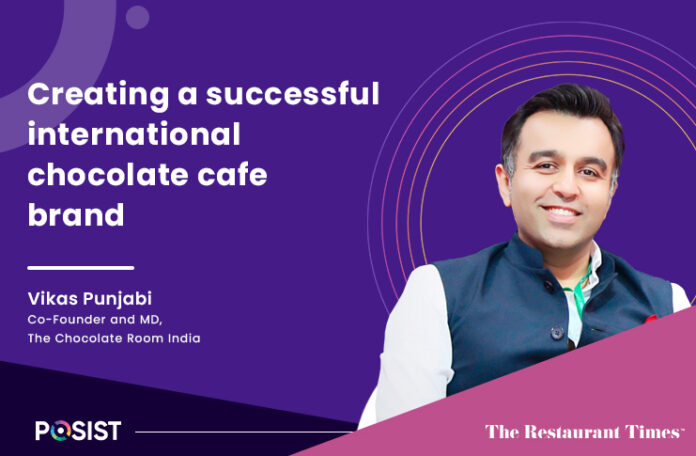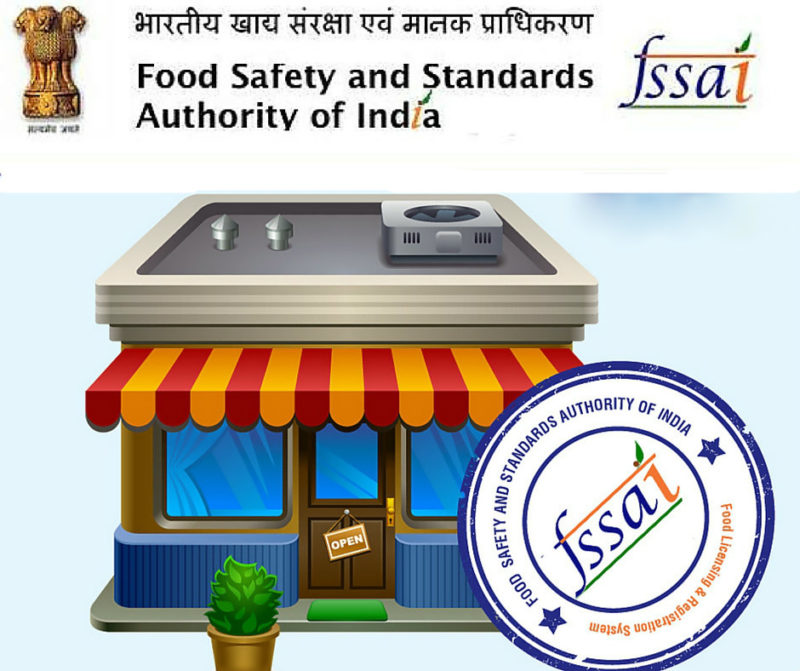Realizing the huge potential of chocolate desserts in India, Vikas Punjabi voyaged from Australia to India in 2007 to launch the first-ever chocolate cafe brand, The Chocolate Room. The brand is known for serving a diverse range of sumptuous chocolate desserts and beverages with a live kitchen experience.
First launched in Ahmedabad, the brand has a presence with 395 outlets across India with an extended presence in around 11 countries. The Chocolate Room (TCCR) serves around 20 flavors of Italian hot chocolate, chocolate fondues, cakes, and special hand-made chocolate desserts prepared with the finest Belgian chocolate.
In Conversation with Vikas Punjabi of The Chocolate Room
With his strong entrepreneurial spirit & effective marketing strategies, Vikas has created a strong brand appeal for TCR. In an exclusive conversation with The Restaurant Times, Vikas Punjabi, MD, and Co-founder, of The Chocolate Room shares insights from his entrepreneurial journey about how to sustain and grow in a competitive market, and the role of menu engineering, consistency, and people strategy in creating a successful brand.
TRT – Considering the depth of your experience in the F&B industry till now, we would like to know about your journey. What were your key learnings, challenges, and major lessons?
Vikas Punjabi – When I was planning to move back to India, I got the master franchise rights of The Chocolate Room for India. And that’s how my entrepreneurial journey started in 2007. My passion for food took over what I had studied and I opened the first outlet of The Chocolate Room in Ahmedabad, Gujarat. When it started out, there were not too many cafes around.
Other than the major brands like Cafe Coffee Day or Barista, there was hardly anything such as a chocolate cafe. So we thought of exploring the market because it was something that had not been tried and tested in the Indian market before. We learned everything from the scratch – right from the basics of serving the customer to managing the restaurant business.
When we started out, it was all about just desserts and beverages. But soon we realized the Indian taste palette doesn’t like too many sweets and that we also need to serve savory dishes. We got a few menu consultants on board, experimented with our menu, and slowly and steadily engineered the menu. Once we had our operations in place we started focusing on growth. By 2008, we figured out that franchising was the way to scale The Chocolate Room brand. Ever since we have been franchising and right now have more than 395 stores across the country. And this number is steadily growing.
TRT – The Chocolate Room has been expanding quite rapidly. We are interested in knowing more about your expansion strategy. Being an entrepreneur, how much importance do you give to expansion strategy? Also, what’s the right time for a brand to consider expanding?
Vikas Punjabi – As for the expansion strategy of The Chocolate Room in India is concerned, we wanted to expand through the franchise route as we didn’t have that many funds to launch new stores by ourselves. That said, we knew that the product had its potential.
People from Mumbai and Delhi would visit our outlet in Ahmedabad and would suggest us to open stores there as well. After thinking about it for a while and listening to the customers, we started taking the idea seriously. That being said, before venturing into franchising we realized that we need to ensure consistency in our packaging and servicing. Most of our raw material is sourced from Belgium and Italy; we cannot afford to go wrong with this. So, we took a year to understand the customer needs better and created an easy-to-replicate model. We were aware of the first-mover advantage we had in the market and didn’t want to lose it. Therefore, we started franchising towards the end of 2008.
We knew the business was doing good and we capitalized on it and took very less time on execution. This is how we got started with the franchising model. If you feel that the customer’s response is positive and you have everything ready to expand with all the business byproducts, everything ready for the business to sustain, you should go for it.
Our strategy is a bit different from others in the space. In India, most franchise companies tie up with franchise consultants and just rely on them. What we’ve done, however, is focus on building our own branding instead of relying solely on franchise consultants. Not to say that franchise consultant are not helpful; they do help in growth. But we prefer setting up our own marketing team. We have also adopted digital marketing wherein we work on SEO, content, paid marketing, and social media consistently. We have also experimented with a lot of digital platforms such as Snapchat and LinkedIn as we understand our audience is diverse.
The Chocolate Room is not like an ordinary cafe where corporate employees go for their meetings. It is a place where all the age groups from the age of 8 to 60 years, everyone goes to enjoy chocolate.
Besides, The Chocolate Room has always been a live kitchen experience, unlike other cafes that serve frozen products. All the desserts and savory dishes are made life in front of the customers, giving a unique experience and fresh taste of food. It helped us stand out from the rest of the cafes that would serve frozen food products. It played a crucial role in our success because there were hardly any restaurants with live kitchens. It put us in a different league.
In our marketing strategy, we promoted the live kitchen amongst this age group heavily on all the online channels. Not many restaurants or cafes focused on the digital marketing aspect and we took this opportunity to build our marketing strategy and team. We also marketed through our franchises. We recommended they use a referral program by giving complimentary vouchers and royalty points to references and regular customers. It helped us build strong word-of-mouth popularity.
These are some of the things that worked out well for our brand. Most of our franchise owners have at least 4 to 5 stores across the country. Now, many restaurants or cafe businesses don’t do this but we have succeeded in developing a strong master franchise network in India. We have found the right people and the right partners.
Many of our franchises came through references. We rely on our own team, resources, and franchises. We have seen this model doing great in the United States and Australia. But in India, most businesses do not explore this and simply rely on franchise consultants. It has been a key differentiator in helping us grow further and maintain consistency not only in India but in other countries as well.
Vikas Punjabi – The menu is a very important aspect of a restaurant business. When we brought TCR to India, we were also new. All we knew was that this product is new to India and we didn’t have too much knowledge other than this. All we knew was we needed to put this brand into people’s minds, hearts, and souls and let them taste and accept our product. Once we succeeded in capturing the audience, we optimized the menu.
The Chocolate Room is the only company in India that serves 12 flavors of hot chocolate. When we say 12 flavors of hot chocolate, it doesn’t mean that we make a simple hot chocolate and add flavors to it. We create different variations using organically cultivated cacao beans from Belgium and Italy in which no flavors are added. They were made from the time of their farming and cultivation. That’s why when you have hazelnut chocolate at TCR, you see those hazelnut chunks and get the real hazelnut flavor in hot chocolate – not any artificial flavor. This is the USP of our menu.
We keep on launching new items on our menu. Besides, it is very important to keep reviewing your menu every 3 to 6 months. For this, you can take feedback from your customers. During Covid lockdown, people stopped coming to eat outside. This is when we decided to create our menu for retail. Everything that was available in our cafes is now available at retail stores in ready-to-cook packaging. We also decided to host competitions and giveaways. It all worked out extremely well for us. During the second wave of Covid in the country, a lot of restaurant businesses shut down. But we didn’t lose a single rupee in our business. This is because we immediately aligned ourselves to the needs of our customers right after the first wave of Covid. We came up with a brownie mix and a hot chocolate spoon. Customers simply need to follow a few steps and they can make their own brownies and hot chocolate at home, in the flavor they like.
These are some of the key changes we made to our menu; each time adapting to the needs of our customers. We feel it is a very important and integral part of running a restaurant business. Your menu, research, and development need to work side by side to give customers a great experience.
TRT – Restaurant staff plays a major role in establishing the goodwill of any brand and one of the major challenges that people encounter these days is finding good talent and people to represent their brand. We would like to know how you overcame the challenges of staffing in all your restaurants.
Vikas Punjabi – Honestly, we haven’t faced this problem as from day 1 I personally engaged with the staff at our stores and understood what they want and how they want to be treated. This taught me that if you treat your staff as family and they stay with you for the first 5 years, you will never have a problem with staffing for the next 25 years or till the time your business sustains.
Working inside the store for the initial three years gave me insights as to how the staff should be made comfortable, taken care of, and given enough freedom to understand and talk about their ideas as well. We all learn from each other every day. So, we have made it a rule that there are regular training and feedback sessions to understand our staff’s viewpoints.
Additionally, we have structured our people strategy in such a way that everyone gets enough opportunities to grow. There are people who were earlier housekeepers and now they’re store managers. We provided English language learning lessons. The company also gave the staff loans to build their houses as well. We also provide added benefits like medical insurance.
When you create such a work environment, your people will make extra effort for the growth of your business. I can strongly vouch that 90% of the initial staff that started with us in 2007 is still working with us even after 15 years. This is because of the teamwork and the company culture.
There’s only one strategy that works with people i.e., listening to them and understanding their needs, and giving them opportunities.
TRT – Having so many outlets brings with it a set of challenges to resolve every day. One of the major challenges is keeping consistency in everything. How do you ensure that every day and each and every outlet serves the same flavor and customer experience?
Vikas Punjabi – To be honest, it is difficult to achieve 100% consistency at the scale we are working on. In my opinion, if you are able to provide the same taste and experience across 80% of your outlets.
At TCR, 90% of the raw material is supplied either from the head office or the main warehouse. This way we are able to ensure that the taste stays the same across all outlets. There’s a whole line of staff that works on our products. We make sure to provide regular training manuals, SOPs (standard of procedures), and graphic manuals in our kitchens. We do all sorts of things but other than that a local franchise and owner also need to keep an eye on.
The store manager must conduct regular auditing and see to it that a consistent taste is maintained. We have similar measuring cups, jugs, spoons, containers, and sachets across all our outlets. This way it is easier to ensure the same recipe is followed. We also give recommendations as to the temperature that needs to be maintained for a recipe. When you have such specifications, it is easier to ensure consistency.
That said, there’s always room for error due to different people working in the kitchen. Around 5-10% of outlets might not be able to maintain this consistency and I am fine with that. A lot depends on the taste and preferences of customers in different cities as well. We have to tailor our recipe, presentation, and decorations accordingly.
TRT – As an entrepreneur, what’s that one habit that has helped you succeed? Is there any advice you would like to give to young entrepreneurs in the industry?
Vikas Punjabi – The best habit is to know that you don’t know everything. You must listen to people, staff, and customers. You must closely follow reviews and feedback. Try to see what needs to be improved.
One must not get overexcited or overconfident about having achieved success and feel that it is going to last their whole life. You must keep on listening and changing. It’s a very competitive market and you will do very well if you keep learning. So that’s my first advice.
At TCR, we have focused on encouraging women and young entrepreneurs. 30% of our franchise owners are women entrepreneurs and we are proud to say that. We ensure that they are supported with proper training. We encourage our franchise owners to follow what their heart says.
















